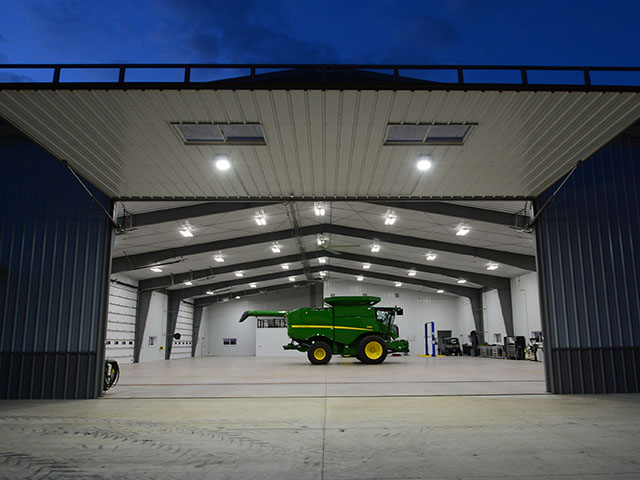Building Bigger Is Better for Best Shop
Create a Farm Shop for Convenience and Comfort
The guiding directive for Cummings Farms' new shop was simple: "It better be big enough. We are only going to do this once." That mandate came from fourth-generation farmer Marty Cummings, the Malcom, Iowa, owner of a corn and soybean operation just north of Interstate 80, midway between Des Moines and Iowa City.
**
BEST IDEA: BUILD IT BIG
Brant Klenk, a long-time employee of the farm, and Cummings' son-in-law, Curtis Michalek, oversaw the project. They went big. At 15,000 square feet (100-by-150 feet), this Topline manufactured steel building could hold the shop it replaced two and-a-half times over.
The side walls are 20 feet tall. Inside the shop, the space is open up to 22 feet above the floor. "The greatest overall benefit of our new shop is that it allows us plenty of room to work on multiple pieces of equipment at the same time," Michalek said.
P[L1] D[0x0] M[300x250] OOP[F] ADUNIT[] T[]
The old shop was hardly big enough to unfold a chisel inside. The new shop has space to unfold 120-foot sprayer booms or take in two combines for maintenance plus a 24-row corn planter.
The day is coming when Cummings Farms will be pulling even larger planters and corn heads inside the shop. When Marty's father (Marvin) built that old shop in 1982, he thought he'd never need anything bigger. "We want to make sure that 20 years from now, this shop still fits this operation," Michalek said.
**
And, the rest of the ideas ...
-- Geothermal. An in-floor heating system is plumbed to a huge geothermal field outside. A geothermal room houses seven Geothermal Systems' GeoComfort units circulating a water solution warmed in the geothermal field. Through an exchanger, the heat captured in the field is transferred to four heating zones inside the shop. Loops under the floor are spaced 18 inches apart, except under the wash area. To handle melting snow from equipment pulled in for cleaning, the loops in the wash area are spaced 12 inches apart.
-- LEDs. Overhead lights are banks of LED (light-emitting diodes) fixtures. LEDs can be two or three times more expensive than even top-end T5 fluorescent fixtures. But they reduce electricity and maintenance costs over the long run. LEDs are said to use up to 75% less energy than incandescent lights and last up to 25 times longer.
-- Door. An 18- x 40-foot hydraulic door opens on the south side of the building, adjacent to the wash area. This door gives equipment access to the length of the building. A nice feature is two LED lights mounted onto the hydraulic door, producing overhead light when the door is raised.
-- Shop Comfort. An upper patio overlooks the shop floor. There is a table, chairs and flat-screen TV. That patio leads into a breakroom complete with a flat-screen TV, a sectional leather couch, a bar/island, full kitchen and full bathroom. And, since we're talking flat screens, an 80-inch screen hangs over the shop floor; sound and music are delivered in surround sound.
**
Editor's Note:
This is one in a series of America's Best Shops. If you have a farm shop you'd like us to feature, send a note to: dan.miller@dtn.com. If we publish your shop story, we'll pay you $500.
Follow him on Twitter @DMillerPF
(c) Copyright 2021 DTN, LLC. All rights reserved.



